|
|
New Boat Review: Bavaria 36 Cruiser
By
Capt. Thom Burns
There is hardly a better place to check
out new boats than the Annapolis Boat
Show. It’s generally not too hot, not
too cold, and it’s outside. Plus the
boats are in the water which makes many
comparisons really meaningful. Sailing a
boat for demonstration or review
purposes is also a treat because
everyone is usually there from the
designer to the builder.
Neither the designer nor the builder of
Bavaria Yachts was at Annapolis this
past October. Bruce Mundle, Managing
Director of Bavaria, USA was there with
his staff and they were a busy group.
Bruce showed us the boats and took us
sailing after the show.
|
|
The Yachts are built in Germany. While
Bavaria Yachts is relatively new to
North America, they are certainly not
new in Europe. They have been building
production boats for decades. In there
last reported year they built nearly
1,700 yachts. They are the largest
builder in Germany and number two in the
world. According to Bruce Mundle,
Managing Director of North American
Operations, the company was able to
double capacity this past year with the
addition of less than a dozen workers.
When you are already rolling out 2,000
boats a year the new capacity is both
impressive and an immediate challenge to
domestic production builders. Bavaria
has been able to ramp up production
efficiently because of their high tech
production lines and facilities backed
up by state of the art technology and
German engineering.
The manufacturing facilities are south
of Frankfurt near the tip of the
Bavarian region in the small town of
Giebelstadt. The town is no where near
any major bodies of water, but it is
within twenty-four hours of the Baltic,
Mediterraen and Atlantic by truck. The
property for the new facility came from
a closed U.S. Air Force Base.
Deck Layout
This vessel is designed with the couple
or single-handed sailor in mind. It is
thus very family friendly for young
families. The decks are remarkably clean
and uncluttered. On the bow there is a
built in self-draining, anchor locker, a
stainless steel bow fitting with anchor
roller and a chafe guard.
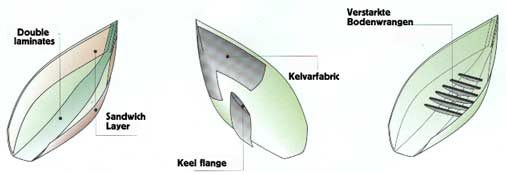 |
| Double Laminates:
Double Laminates Sandwich Layer: Sandwich Layer Keel Flange: Keel Flange Kelvar fabric: Kevlar Fabric Verstarkte Bodenwrangen: Verticle Reinforcements |
The rig is a 9/10 fractional with two
sets of slightly swept back spreaders on
Selden spars with a positive action gas
cylinder boom vang. Either an in mast
furling mainsail or a full-battened main
are standard. The full-battened main is
45 sq. ft. larger. Since we have a lot
of light air on our Great Lakes in July
and August, the larger main would be my
preference. The standard genoa is on a
Furlex headsail system.
All lines lead aft to the cockpit. The
mainsail trims from the center of the
boom onto a traveler located just
forward of the companionway. The winches
are Harken and the hatches are Lewmar.
The wheel comes standard with a leather
cover. The cockpit is reasonable for a
36’ boat which maximizes space below. It
has a walk through transom and a hot &
cold deck shower.
Accommodations
As I descended the companionway steps, I
immediately liked the brightness from
the overhead and coach sides, both of
which are white. The cabin sole is
“never-wear” which looks like teak but
is virtually maintenance free. The
cabinet and cabin doors are solid wood.
All of the locker and cabinet doors are
finished on the edges. One of the things
that impressed me was that every hinge
and latch on every drawer, locker, door,
cabinet, . . . even the engine
compartment were the same. It reminded
me of the IKEA approach to efficiency.
The galley has a stainless steel double
sink with easy access to the ice box
which has built in 12 volt
refrigeration. There’s a gimbaled, two
burner propane stove with oven, covered
trash disposal and good provision
storage.
The navigation station is across from
the galley facing forward. It is well
appointed for a thirty six foot boat.
Instrument displays are located directly
in front of the nav table. There’s
stowage under the chart table, above to
starboard and under the nav seat.
The main salon is open and airy with a
table for six mounted with a drop leaf
for easy fore and aft passage. It is
also well lighted with six adjustable
lights strategically placed in the
overhead. It has several opening hatches
with roller blinds and six opening ports
with curtains for enhanced cross
ventilation.
The boat we sailed was a three cabin
model with two aft cabins. This
arrangement gives opposite sex children
their own space. The cabins are big
enough for a couple short term.
The forward head has a good size door
and there is adequate shoulder room with
a pull down seat for showering. There is
also a hanging wet locker. All head
surfaces are of an “easy care, easy
clean” type.
The forward stateroom is light, airy
with a closet, sit rest and a series of
cabinets fore and aft on both sides.
Overall this is a well done and well
planned interior which I would be happy
to show my guests.
Construction
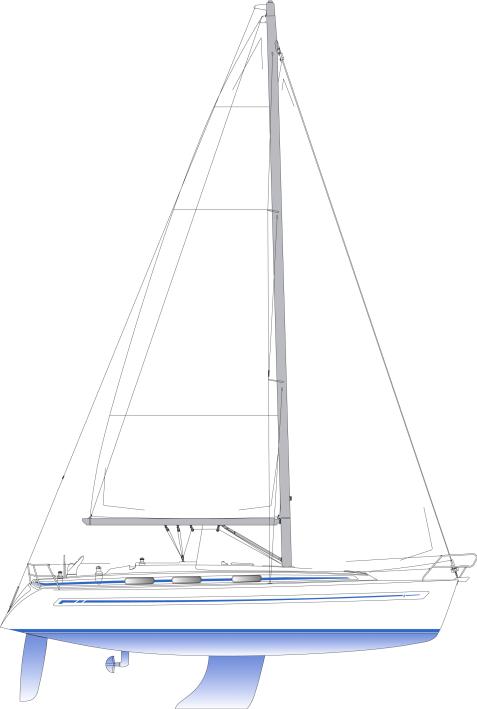 |
| Note how far forward the sail-drive unit is from the rudder. |
The major difference between Bavaria and
every other production builder that I am
aware of is that they build their boats
beam to beam rather than stem to stern.
This allows different models to cruise
down the same production line. They have
also invested heavily in high-tech,
computer aided manufacturing processes
which should also increase quality
control.
Despite all the automation, the hull is
hand laid solid GRP fiberglass to the
waterline, then it’s foam cored above
the waterline and on deck to save
weight. The boats also feature double
centerline laminates, kevlar bow
sections and reinforced stringers. The
Bavaria line has Lloyd’s Register LRQA
Offshore rating - the highest given in
the pleasure craft industry.
|
|
| All cut-outs and holes are done by computer aided robots. |
Performance
We left Annapolis in light winds under
power. This boat is equipped with a
Volvo MD 2030, 29 hp sail drive. This is
a really slick power unit because it
mounts vertically much closer to the
center of the boat. It does not have the
long shaft and stuffing bearings
associated with traditional diesels. I’m
reluctant to say traditional because so
many manufacturers are moving in the
direction of sail drives. The shaft,
stuffing box, couplers and room they
take are removed. The overall unit is
less expensive while saving space. The
same hull shape has more usable interior
space for deep lazurettes and double aft
cabins.
I put the boat through some spin moves
to both port and starboard. The Bavaria
36 really spins smoothly in a very tight
circle both ways with a slight advantage
to port as would be expected with a
right handed screw. The most notable
difference came when backing the boat
under power. Where’s the prop walk?
Because of the distance between the sail
drive’s prop and the rudder, the boat
backs smoothly with only a little prop
walk which is easily overcome with a
rudder unencumbered with prop wash. This
boat handles very well under power which
I attribute to its incredible balance
due to the design and placement of the
sail drive unit.
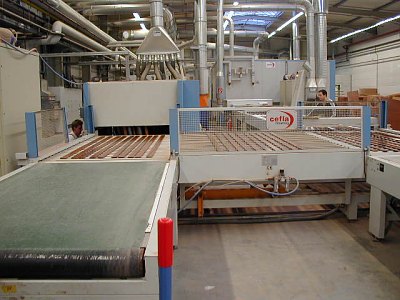 |
| All wood pieces are cut and painted or varnished by machine. |
Under sail we had a typical light wind
July day in October. The roller furling
main worked very smoothly as advertised.
The genoa set nicely and the boat moved
about 2.1 knots in gusts of 5 or 6
knots. We were lucky to get some wind
for twenty minutes or so in the range of
8 to 10 knots. The boat sailed well and
tracked beautifully with finger tip
control on the wheel or no hands on the
wheel at all. It is a very well balanced
boat.
The sheets and lines which are all led
back to the cockpit leave a clean deck
and open cockpit adding to the enjoyment
with less clutter. I have no doubt that
the Bavaria 36 is a pleasure to sail. A
quick perusal of the owners groups and
events indicate people are doing great
things with their boats. When we were
ready to come in after our mostly light
wind sail, it took more time to put the
fenders on than to secure the two roller
furling sails.
Conclusion
When Bavaria is mentioned in my familiar
U.S. sailing circles most sailors I know
wonder if it’s the latest trendy micro
brewery and where it might be located.
Sailing to Europe took me to Ireland,
France and Spain over the past few years
where I roamed the docks looking at the
boats. I saw a lot of Bavaria Yachts in
the mix which surprised me since before
then I hadn’t known about them myself.
Most were sailed by couples or families
of four or so, often with younger kids.
This bodes well for sailing, at least in
Europe.
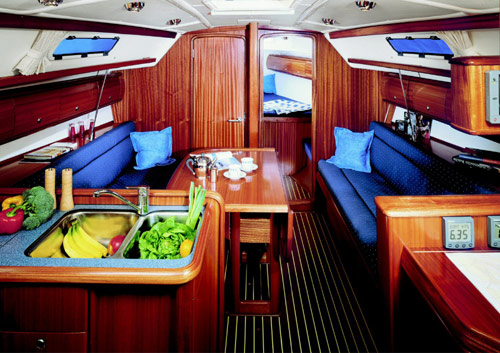 |
Bavaria has taken the approach of
investing heavily in high-tech
production with quality craftmanship in
an effort to cut production costs,
produce a quality product and increase
units produced. At the same time several
other manufacturers have taken the
approach of cutting back production to
their highest efficiencies using older
production techniques while raising
prices and encouraging custom orders.
The good part is that the savings from
the Bavaria approach are passed on to
consumers in lower costs. The bad part
is that the $Euro versus the $U.S.
exchange rate may negate the savings to
U.S. customers in the near future.
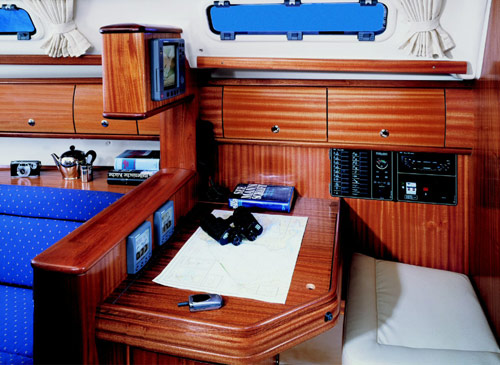 |
| Nav Station |
The success of the Bavaria line in the
marketplace is clearly their value. You
should not have to explain to your
significant other why you need an extra
ten to twenty thousand dollars in extras
to make the boat “right.”
A new, well-equipped, sail-away Bavaria
36 Cruiser will price out at under
$149,000. The boat comes with a laundry
list of standard features many of which
are extras on other boats. The value
becomes apparent when strolling around a
major boat show comparing this boat to
its competitors.
| Bavaria 36 Specs Length overall 37’10” Length hull 32’6” Length waterline 30'10” Beam 11’10" Water tank 80 gal. Diesel tank 40 gal. Draught (standard) 5'1"” Deep Lead (option) 6’5” Displacement 12,100 lbs. Ballast 2,330 lbs. Furling mainsail 290 sq. ft. Battened mainsail 335 sq. ft. Genoa 320 sq. ft. Height of mast above waterline 50’6" |
How are they doing it? By using good
old-fashioned economic principles of
lower production costs driven by higher
capital investment in state-of-the-art
technology. I believe you will
appreciate the solid engineering behind
these boats.
If I have any critique of the boat at
all, it is very minor and involves the
darkness of the African Mahogany finish.
I would personally lighten the finish up
a couple of shades. This is a minor
quibble. The strongest plus is that the
boat sails well and the sailaway
specifications are actually true. There
is a lot to be said for buying the right
boat with the right gear on it with no
surprises.
Personal preference recommendations on
my part would be to select the deeper
draft lead keel and the full-battened
mainsail.
The challenge for Bavaria will be to
maximize their presence in the U.S.
market to make all that high-tech
investment pay off in increased sales.
As consumers, I would give Bavaria a
good, careful look. You are likely to be
pleasantly surprised.
Capt. Thom Burns publishes Northern
Breezes and Sailing Breezes Internet
Magazine.
For more info: Hooper’s Yachts,
Afton, MN 651-436-8795
www.hoopersyachts.com
Bavaria Yachts USA
410-990-0007
www.bavariayachts.com